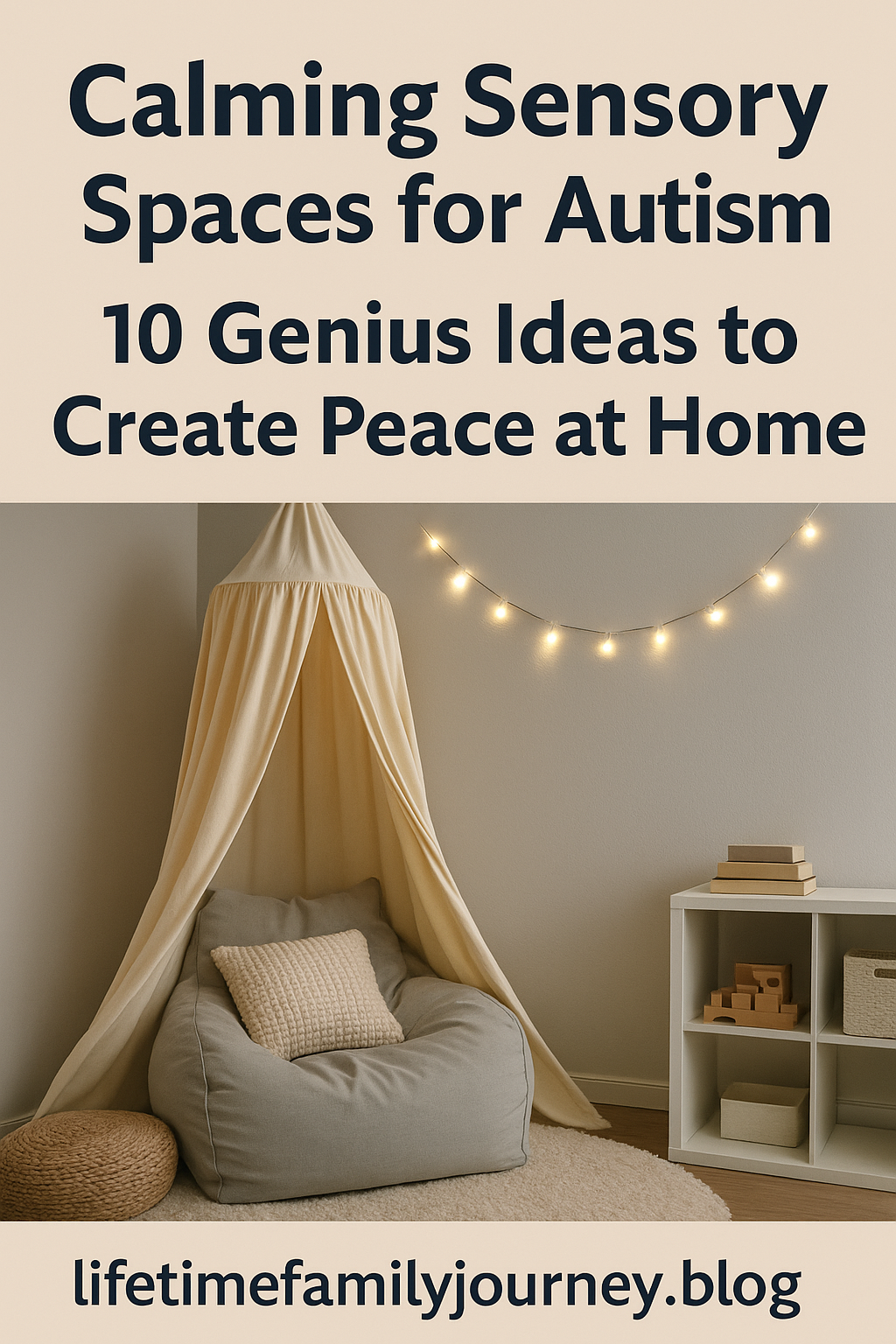Calming Sensory Spaces for Autism: 10 Genius Ideas to Create Peace at Home

Creating calming sensory spaces for autism doesn’t require a massive budget or professional installation. It’s 4:47 PM on a Wednesday. Your autistic child just walked through the door after seven hours of sensory bombardment at school. The fluorescent lights, crowded hallways, and constant noise have pushed them to their breaking point. Within minutes, the meltdown begins—and with it, the ripple effect that leaves everyone in your household walking on eggshells.
Sound familiar? You’re not alone.
After fifteen years of homeschooling and raising six kids, I’ve learned that sensory overload doesn’t just affect the child having the meltdown—it impacts the entire family dynamic. The good news? Creating effective calming sensory spaces for autism can transform even the smallest corner of your home into a game-changing sanctuary that helps your autistic child self-regulate and find peace.
These ten genius ideas for calming sensory spaces for autism work whether you’re living in a studio apartment or a five-bedroom house. I’ve tested every single one with families across different living situations, budgets, and sensory needs. Some calming sensory spaces for autism cost nothing more than rearranging what you already own.
Why Creating These Spaces Changes Everything for Families
Understanding why calming sensory spaces for autism work is crucial for implementation success. Autistic brains process sensory information differently than neurotypical brains. Some kids crave extra sensory input—they’re the ones jumping on furniture, seeking tight hugs, or making loud noises. Others become overwhelmed by everyday sounds, textures, or lights that most people barely notice.
Without designated calming sensory spaces for autism, that overwhelm builds throughout the day like pressure in a kettle. Eventually, something has to give.
A study found that when autistic children could control sensory equipment in multi-sensory environments, they showed fewer repetitive and sensory behaviors and increased attention. But here’s what the studies don’t capture—the relief these spaces provide for parents and siblings too.
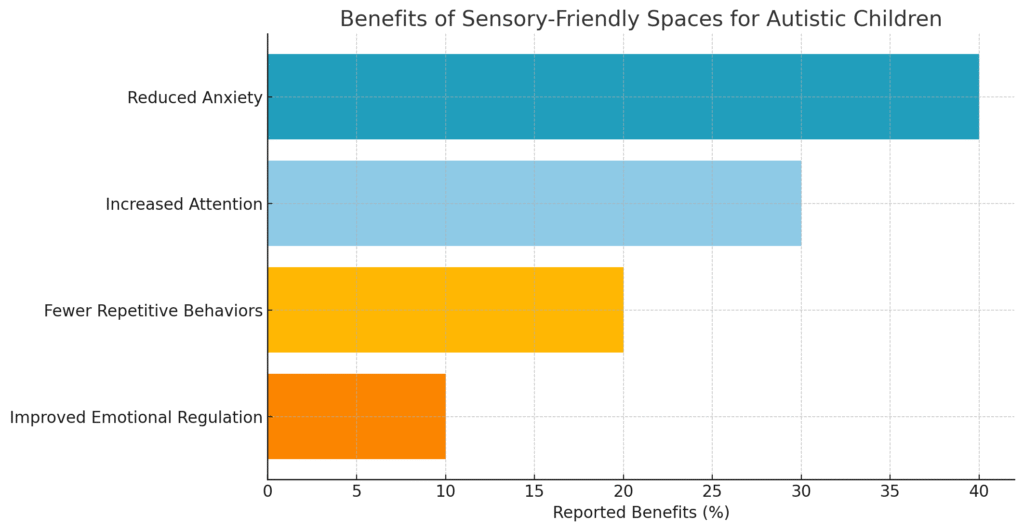
When your autistic child has calming sensory spaces for autism to retreat and recharge, the entire household becomes calmer. Sibling arguments decrease. Parental stress drops. Even family dinners become more peaceful when everyone knows there’s a safe space available if things get overwhelming.
The Four Foundation Elements Every Space Needs
Before diving into specific ideas, understand that all effective calming sensory spaces for autism incorporate these four core elements:
🔅 Lighting That Soothes Instead of Stimulates
Harsh overhead lighting is sensory kryptonite for many autistic kids. Swap bright bulbs for warm, dimmable options. String lights create magical ambiance without overwhelming brightness. Lava lamps provide mesmerizing movement that helps some children focus and calm.
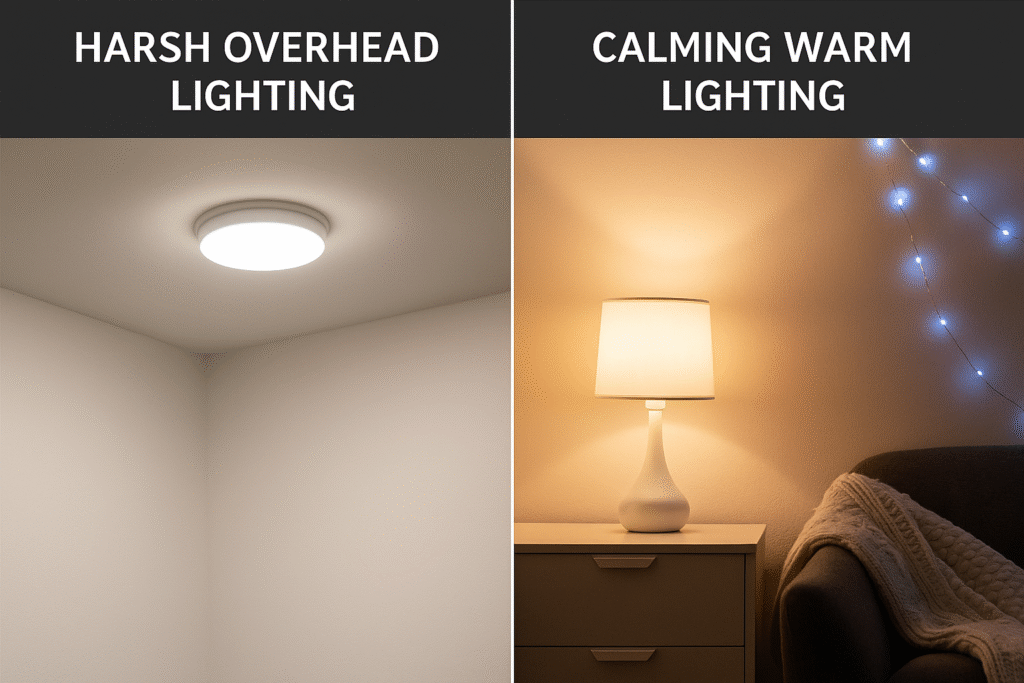
Apartment hack: Can’t change fixed lighting? Use lampshades, colored bulbs, or even blackout curtains to create softer environments in any corner.
🧸 Textures That Invite Touch and Comfort
Different textures serve different sensory needs. Weighted blankets provide deep pressure that calms nervous systems. Soft rugs offer tactile input underfoot. Bean bags conform to body shapes for proprioceptive feedback.

Budget version: Fill pillowcases with rice for DIY weighted lap pads. Use old towels and blankets to create texture variety without spending money on specialized equipment for calming sensory spaces for autism.
🔇 Sound Management for Peace
Some autistic children need complete silence to decompress. Others find comfort in consistent background noise. Noise-canceling headphones work for both situations. White noise machines mask household chaos. Even a simple fan can provide steady, soothing sound.

Rental-friendly option: Headphones are portable and don’t require permanent installation—perfect for apartments or shared spaces.
🌿 Scents and Air Quality
Pleasant scents can enhance relaxation, but be cautious—many autistic individuals have scent sensitivities. When in doubt, skip artificial fragrances entirely. Natural options like lavender sachets provide gentle aromatherapy without overpowering small spaces.
Important note: Always test scents gradually. What relaxes one child might trigger sensory overload in another.
10 Genius DIY Ideas That Transform Any Space Into Calming Sensory Spaces for Autism
1. 🏕️ The Pop-Up Tent Sanctuary
Perfect for: Renters, small spaces, temporary solutions
Transform any room corner with a simple pop-up tent. Add battery-operated string lights, soft pillows, and a weighted blanket. This creates an instant retreat that can be assembled or stored in minutes.
Why it works: The enclosed feeling provides security while soft lighting and textures offer sensory regulation. Kids love having their own “special place” that feels separate from household chaos. This represents one of the most versatile calming sensory spaces for autism.
2. 🪑 The Sensory Chair Station
Perfect for: Families with limited floor space
Designate one comfortable chair as the official calm-down spot. Equip it with a lap-weighted pad, noise-canceling headphones hanging on the armrest, and a basket of fidget tools underneath.
Pro tip: Choose a chair that faces away from high-traffic areas. The back of the chair creates natural boundaries while the child can still observe the room if needed.
3. 💡 The Mood Lighting Corner
Perfect for: Kids who are sensitive to bright lights
Create a corner using only alternative lighting sources. Combine lava lamps, fiber optic lights, and soft LED strips. Add light-filtering fabric or sheer curtains to diffuse any remaining room light.
Bonus feature: Many autistic children find moving lights fascinating and calming. The visual stimulation can redirect anxious energy into focused observation.
4. 🎵 The Sound Sanctuary
Perfect for: Noise-sensitive children or busy households
Establish a quiet zone with sound-absorbing materials. Hang thick blankets on walls, add area rugs, and include multiple sound options—headphones, a white noise machine, and even a small speaker for calming music.
Parent reality check: This isn’t about perfect silence. It’s about giving your child control over their auditory environment when the world feels too loud.
5. 🏊 The Sensory Bin Station
Perfect for: Kids who crave tactile input
Create a dedicated space for rotating sensory bins filled with rice, beans, kinetic sand, or water beads. Store bins on low shelves where your child can access them independently. Include scoops, containers, and small toys for exploration.

Mess management: Place bins inside a large cardboard box or plastic storage container to contain spills. Keep a small vacuum or dustpan nearby for quick cleanups.
6. 🤸 The Movement Zone
Perfect for: Active kids who need physical input
Even in small spaces, create opportunities for safe movement. A mini trampoline, balance board, or exercise ball provides proprioceptive input that many autistic children crave.

Apartment solution: Look for equipment designed for small spaces—balance boards that fit under beds, resistance bands that hang from doorframes, or foam blocks for safe jumping.
7. 🧘 The Mindfulness Nook
Perfect for: Children learning emotional regulation skills
Combine comfortable seating with visual cues for breathing exercises. Include a feelings chart, breathing buddy (stuffed animal for deep breathing practice), and simple mindfulness tools like stress balls or thinking putty.
Teaching opportunity: This becomes a space where children can practice the coping skills they’re learning in therapy or at school.
8. 🎨 The Creativity Calm Station
Perfect for: Kids who find art therapeutic
Set up a small table with art supplies that don’t require supervision—crayons, coloring books, sketch pads, stickers. The focus on creating provides mental distraction while the repetitive motions can be soothing.
Storage solution: Use a rolling cart that can be moved when the space is needed for other purposes. Everything stays organized and accessible.
9. 🔄 The Rotating Sensory Wall
Perfect for: Growing children with changing needs
Create a wall space where different sensory tools can be easily swapped. Velcro strips, small hooks, or magnetic boards allow you to change textures, fidgets, and visual elements based on your child’s current preferences.
Growth factor: What calms a six-year-old might not work for a twelve-year-old. This setup evolves with your child’s developmental needs.
10. 🌍 The Portable Peace Kit
Perfect for: Families who need flexibility
Sometimes the best space isn’t a place—it’s a kit that travels. Fill a basket or bag with your child’s favorite sensory tools, a small blanket, headphones, and a few comfort items. This “kit” can create calming opportunities anywhere in your home.
Real-world benefit: Works for families dealing with multiple living situations, frequent moves, or children who need regulation support in different rooms throughout the day. This flexibility makes portable kits essential components of calming sensory spaces for autism.
📥 Free Resource for Families
Want a quick-reference version of these ideas? Download my free Calming Sensory Spaces Interactive Guide — a printable PDF with foundation elements, DIY tips, budget options, and real family success stories.
👉 Download the Free Guide
Matching Calming Sensory Spaces for Autism to Your Child’s Unique Profile
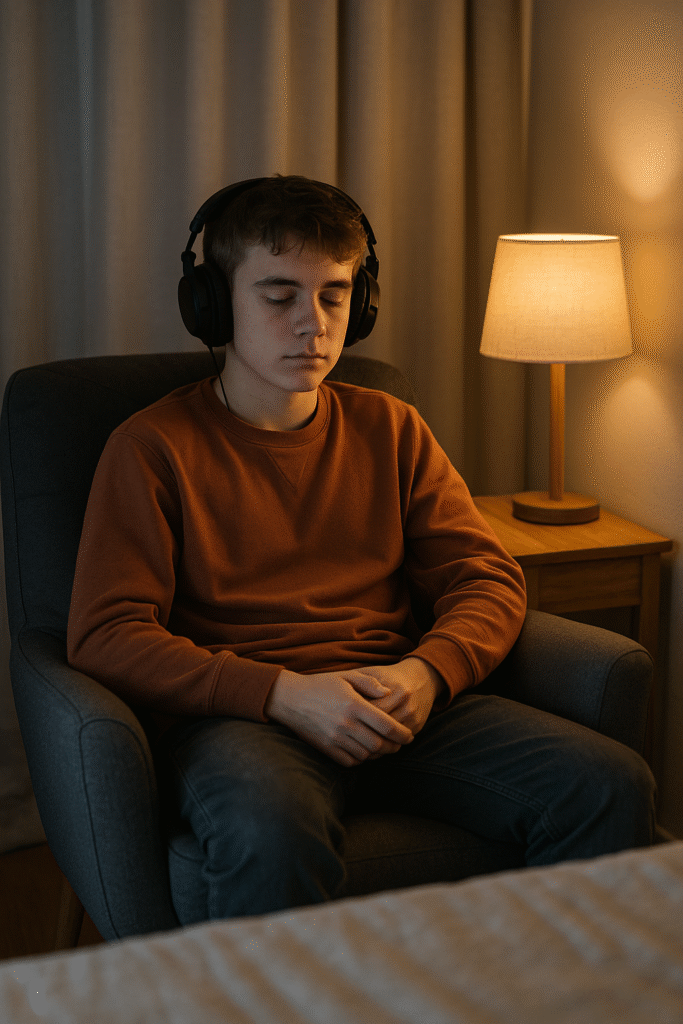
Not all autistic children have the same sensory needs. Understanding whether your child seeks sensory input or tries to avoid it will guide your approach to creating calming sensory spaces for autism.
Sensory seekers might benefit from:
- Heavier blankets and compression items
- Textured surfaces to touch and explore
- Movement opportunities like swings or trampolines
- Brighter or changing lights
Sensory avoiders often prefer:
- Soft, consistent textures
- Dimmer, steady lighting
- Minimal sound or noise control options
- Fewer overwhelming visual elements

Many children are both—seeking some types of input while avoiding others. Pay attention to your child’s responses and adjust accordingly. What works during one developmental phase might need modification as they grow.
The key is involving your child in the process. Ask what feels good, what they’d like to try, and what makes them feel worse. Their input is more valuable than any expert recommendation when designing calming sensory spaces for autism.
Practical Setup Tips That Save Your Sanity
Start Small and Build Gradually
Don’t try to create the perfect space overnight. Begin with one element—maybe just a comfortable cushion and a pair of headphones. Observe how your child uses it, then add pieces based on their responses to build effective calming sensory spaces for autism.
Reality check: The Instagram-perfect sensory room with thousands of dollars of equipment isn’t necessary. Some of the most effective calming sensory spaces for autism I’ve seen cost less than $50 total.
Establish Clear Boundaries
Make the space sacred. Siblings need to understand that calming sensory spaces for autism are not for playing or socializing unless the autistic child invites them in. This isn’t about exclusion—it’s about preservation of function.
Family rule suggestion: “The calm space is for when someone needs to feel better. We ask before entering and respect if someone says no.”
Keep It Accessible
Location matters more than perfection. Effective calming sensory spaces for autism tucked in difficult-to-reach areas won’t get used during moments of sensory overload. Choose somewhere your child can access independently when they recognize early warning signs.
Teenager consideration: Older kids might prefer spaces in their bedrooms for privacy, while younger children might need spaces in common areas where parents can provide support.
Plan for Maintenance
Calming sensory spaces for autism require upkeep. Sensory bins need refilling. String lights burn out. Weighted blankets need washing. Build these tasks into your household routine so the space remains functional when needed most.
Involve the family: Older siblings can help maintain supply bins. Even young children can help put items back in their designated spots after use.
Creating Calming Sensory Spaces for Autism in Challenging Living Situations
Small Apartments and Shared Bedrooms
Limited space doesn’t mean limited options for calming sensory spaces for autism. A tension rod with curtains can section off a corner. Under-bed storage contains sensory tools that can be quickly accessed. Vertical wall space holds fidgets and visual items.
Shared room strategy: Create a “calm kit” that can move to different areas—the living room during homework time, the bedroom before sleep, even the bathroom during overwhelming moments.
Rental Properties and Temporary Housing
No permanent modifications needed for calming sensory spaces for autism. Use removable Command strips for hanging items. Choose furniture that serves multiple purposes. Focus on portable elements that can adapt to changing living situations.
Moving frequently? Invest in comfort items that travel well—favorite blankets, noise-canceling headphones, familiar scents. Consistency becomes even more important when environments keep changing.
Multi-Child Households
Everyone needs space to decompress. Consider creating multiple small calming sensory spaces for autism instead of one large area. A calm corner in the living room, a sensory bin in the playroom, a quiet spot in each child’s bedroom.
Fairness factor: Other children might want their own “special spaces” too. This isn’t about autism privilege—it’s about recognizing that all kids benefit from having places to recharge.
When Calming Sensory Spaces for Autism Aren’t Enough
Sensory environments are tools, not cure-alls. If your child’s sensory struggles significantly impact daily functioning, consider additional support beyond creating calming sensory spaces for autism:
- Occupational therapy can provide personalized sensory integration strategies
- Behavior therapy helps develop coping skills for overwhelming situations
- Medical evaluation might identify underlying conditions affecting sensory processing
The space you create supports professional interventions—it doesn’t replace them. Think of calming sensory spaces for autism as creating the optimal environment for your child to practice and apply the skills they’re learning elsewhere.
Disciplining Autistic Children: Proven Strategies That Work offers additional approaches for supporting your child’s self-regulation skills.
Budget-Friendly Shopping and DIY Alternatives
Dollar Store Sensory Tools
Amazing finds for under $5: Stress balls, slinkies, textured toys, small lamps, decorative lights, storage bins, soft throws, and craft supplies for DIY projects.
Repurpose What You Already Own
Get creative with household items: Old blankets become tent walls. Mason jars hold fairy lights. Rice in socks creates weighted lap pads. Empty boxes become sensory exploration containers.
Smart Shopping for a Busy and Large Family includes specific strategies for finding sensory-friendly items without breaking your budget.
Gradual Investment Strategy
Month 1: Basic comfort items—pillow, blanket, simple fidgets
Month 2: Lighting improvements—string lights, lampshade, blackout option
Month 3: Sound management—headphones, white noise source
Month 4: Interactive elements—sensory bin materials, art supplies
This approach spreads costs while allowing you to assess what works before investing in more expensive items.
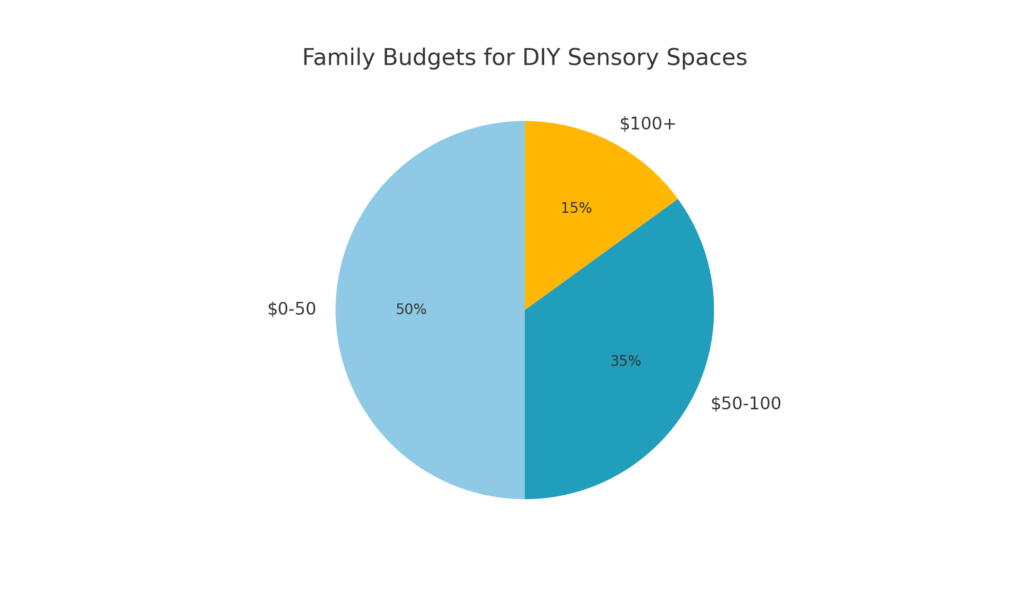
The Ripple Effect: How Calming Sensory Spaces for Autism Transform Entire Families
Here’s what surprised me most about creating these spaces—they don’t just help the autistic child. The whole family starts using well-designed calming sensory spaces for autism.
I’ve watched neurotypical siblings gravitate toward calm corners when they’re upset. Parents find themselves sitting in the sensory space after stressful days. Even grandparents appreciate having a designated quiet spot during busy family gatherings.
The message becomes clear: Everyone needs spaces to decompress and recharge. By creating calming sensory spaces for autism for your autistic child, you’re modeling emotional regulation and self-care for the entire family.
The investment in peace pays dividends beyond the immediate sensory benefits. Meltdowns decrease. Family stress reduces. Everyone learns that it’s okay to need space to feel better.
Making Calming Sensory Spaces for Autism Work Long-Term
Sensory needs change as children grow. What works for a preschooler won’t necessarily appeal to a teenager. Build flexibility into your approach when designing calming sensory spaces for autism:
- Elementary years: Focus on textures, movement, and basic emotional regulation tools
- Middle school: Add privacy elements and more sophisticated fidgets
- High school: Incorporate technology-free zones and independence-building features
The goal shifts from providing sensory input to teaching self-advocacy. Older children learn to recognize their needs and create effective calming sensory spaces for autism independently.
Family Communication Strategies: 7 Proven Home Changes provides additional tools for helping autistic children express their sensory needs effectively.
Beyond the Physical Space: Creating Emotional Safety in Calming Sensory Spaces for Autism
The most effective calming sensory spaces for autism won’t work without emotional safety. Children need to know they can retreat without judgment, spend as much time as needed without rushing, and leave when they’re ready without interrogation.
Family mindset shifts:
- From “What’s wrong with you?” to “What do you need right now?”
- From “Just calm down” to “Let’s find what helps you feel better”
- From “You’re being too sensitive” to “Your feelings are valid”
This emotional foundation makes calming sensory spaces for autism truly therapeutic rather than just decorative.
Simple Maintenance Routines That Keep Spaces Functional
Create weekly check-in routines:
✅ Monday: Refresh sensory bin materials
✅ Wednesday: Test electronic equipment (lights, sound machines)
✅ Friday: Wash comfort items and restock supplies
✅ Sunday: Ask your child what’s working and what needs changing
Involve your child in maintenance of calming sensory spaces for autism. This teaches responsibility while ensuring the space continues meeting their evolving needs.
Building Healthy Family Routines That Actually Work (From a Dad of 6) includes additional strategies for incorporating sensory space maintenance into household routines.
When Multiple Children Share Sensory Needs
Large families often have multiple children with different sensory profiles. Creating individualized calming sensory spaces for autism within shared areas requires creativity:
- Color-code storage bins for each child’s preferred items
- Establish clear time-sharing schedules for popular spaces
- Create portable kits so children can personalize any area temporarily
- Use room dividers to create separate zones within shared rooms
The key is preventing calming sensory spaces for autism from becoming a source of conflict. Clear boundaries and fair access prevent sibling disputes that defeat the purpose entirely.
Red Flags: When Professional Help Is Needed
While calming sensory spaces for autism provide significant benefits, some warning signs indicate additional support is necessary:
- Sensory reactions interfere with eating, sleeping, or basic daily activities
- Meltdowns occur multiple times daily despite environmental modifications
- Your child shows regression in previously mastered skills
- Sensory issues prevent participation in necessary activities like school or medical care
- Family relationships suffer significantly due to sensory-related conflicts
Remember: Seeking professional support doesn’t mean you’re failing as a parent. It means you’re providing comprehensive care for your child’s needs.
The CDC’s Autism Spectrum Disorder information page provides resources for finding qualified professionals in your area.
Real-Life Success Stories That Inspire Hope
The 10-year-old who stopped having daily meltdowns after school once his family created a pop-up tent with dim lighting and soft music in his bedroom corner. He learned to retreat immediately upon arriving home, decompress for 20 minutes, then join family activities calmly.
The 7-year-old who began completing homework independently after her parents set up a sensory bin station next to her desk. The tactile input from rice play between math problems helped her brain stay regulated during challenging tasks.
The 13-year-old who started inviting friends over once his family created a basement hangout space with alternative lighting and sound control options. He felt confident hosting social activities when he could manage the sensory environment.
These aren’t miracle cures—they’re practical solutions that address real challenges families face every day. Small environmental changes in calming sensory spaces for autism create opportunities for bigger life improvements.
Your Next Steps: Starting Today
Don’t wait for the perfect setup or unlimited budget. Begin creating calming sensory spaces for autism with one small change:
- Identify one corner where your child can retreat when overwhelmed
- Add one comfort element—a soft blanket, a pair of headphones, or a simple fidget tool
- Establish one family rule about respecting calming sensory spaces for autism when someone needs it
- Observe for one week how your child uses this minimal setup
- Ask your child what they’d like to add or change
The magic isn’t in expensive equipment or picture-perfect Instagram spaces. It’s in creating an environment where your autistic child knows they can find peace, regulation, and acceptance exactly as they are through thoughtfully designed calming sensory spaces for autism.
Every family deserves the relief that comes from having spaces designed for decompression rather than stimulation. Every autistic child deserves calming sensory spaces for autism that support their unique nervous system rather than overwhelming it.
Start small. Start today. Start with love.
Your family’s journey toward greater peace and understanding begins with that first soft blanket in a quiet corner. From there, you’ll discover what works, what doesn’t, and how powerful it feels when everyone has a place to breathe.
Family Game Night: 25 Best Games That Actually Work and Rainy Day Family Activities: 25 Creative Indoor Adventures provide additional ideas for creating positive family experiences that support sensory regulation.
✨ Keep This Handy
Don’t forget — you can grab the full printable Calming Sensory Spaces for Autism Guide with step-by-step setup tips, budget hacks, and maintenance checklists.
👉 Get the Free PDF Guide
Explore More from Our Family of Blogs
Mountains Will Move
Faith-based encouragement for everyday families.
Everyday Exposed
No-filter truth hub for critical thinking and clarity.
Thank you for being part of the community. God Bless you and your family.
